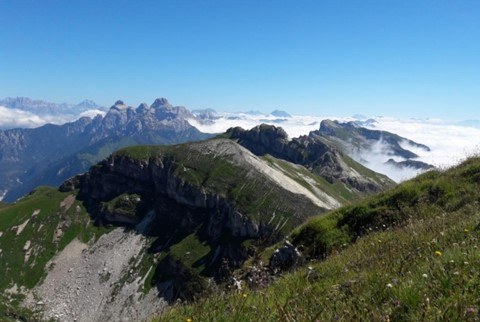The first inventory of lichens of the Dolomites, available online
Created thanks to the Dolichens project and coordinated by the University of Bologna, the database, constantly updated, collects about 75,000 data referring to about 1750 species: more than half of those known for the entire Alpine region
A glimpse of the landscape in the Dolomiti Bellunesi National Park with a view of the Vette Feltrine chain and the Cimonega peaks in the background. An area rich in biodiversity and of considerable biogeographical interest that is home to many interesting lichen species
An online searchable database, constantly updated, which offers an inventory of the lichens of the Dolomites: around 75,000 data referring to about 1750 species, more than half of those known for the entire Alpine region. Presented in the magazine MycoKeys, the database was created thanks to the Dolichens project coordinated by lichenologists from the University of Bologna.
“Despite the fact that the Dolomite region is among the best known and most explored areas in Italy by lichenologists, until now there was no publicly available summary data,” explains Juri Nascimbene, Professor of Systematic Botany at the Department of Biological, Geological and Environmental Sciences at the University of Bologna, who coordinated the study. "But inventories of this kind are extremely important for developing research in nature conservation and promoting biodiversity conservation.”
Communities of lichens of the genus Cladonia that frequently grow on dead wood, especially in forests less disturbed by human action
Despite their valuable contribution to the functioning of ecosystems, and despite the fact that they are organisms that are very sensitive to climate change and pollution, relatively little is still known about lichens, which are often excluded from conservation efforts.
Hence the long and complex work of the University of Bologna scholars, who have aggregated data from numerous sources from the early 1800s to the present day.
"All available literature was consulted, including grey literature such as dissertations, which contain data that is not easily accessible," Nascimbene adds. "Historical herbaria of local interest were then consulted and reviewed, and unpublished data from the scientific work of our research group was also added.”
Rusavskia elegans is a lichen with a northern holarctic distribution common on well-lit dolomitic rocks where it often forms populations that can be observed even from a great distance
And that’s not all: all the reports in the database have been accurately geo-referenced.
In addition, all entries in the database have been meticulously geolocated through extensive posterior georeferencing efforts.
"Each collection location was identified on a map, assigning a pair of coordinates when not already present," Nascimbene states. "For historical data, this proved to be a real challenge: we had to consult old maps, as place names frequently changed over time or were abandoned.”
Distribution map of lichen occurrences in the study area. The dark purple line indicates the core area, where data collection was concentrated. It includes all the Italian Dolomites, in addition to the 9 UNESCO sites, and the Lower Dolomites, in the Venetian Pre-Alps. In violet, the surrounding buffer area, for which data was collected if present in the sources consulted, in view of a future project: the inventory of lichens in the Italian Eastern Alps
The Dolomites area boasts a long tradition of lichenological exploration in the past two centuries: the oldest data come from the herbarium samples of Alberto Parolini (1788-1867), an Italian botanist who mainly explored the Venetian Pre-Alps during the first half of the 19th century. This was followed by a number of other scholars who produced valuable catalogues and collections. Until the 1980s, when the rediscovered national interest in lichenology led to frequent explorations, monitoring activities and collaborations with protected areas and local authorities. All this historical and recent data has now been brought together in the new online catalogue edited by researchers from the University of Bologna.
"This project not only expands our scientific knowledge, but also promotes future studies aimed at the conservation and enhancement of lichens," Nascimbene says in conclusion. "Having at our disposal data from two centuries of exploration, with accurate information on the collection location, in fact provides us with the fundamental tools for future bio-geographical, taxonomic and floristic research, aimed at fully understanding the responses of lichens to global changes.”
The study was published in the journal MycoKeys under the title 'The Dolichens database: the lichen biota of the Dolomites.' Participating for the University of Bologna were Juri Nascimbene, Luana Francesconi, Gabriele Gheza and Chiara Vallese from the Department of Biological, Geological and Environmental Sciences, while from the University of Trieste, Department of Life Sciences, were Stefano Martellos, Matteo Conti and Pier Luigi Nimis.









